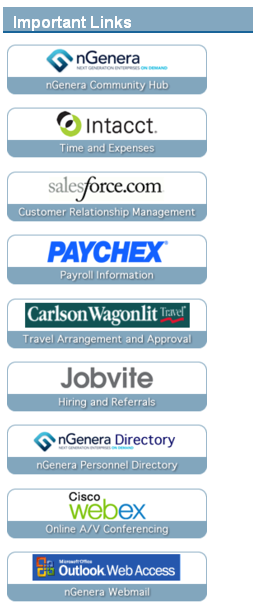 I try carefully not to post too much about nGenera on this blog, as its focus is centered more generically on trends in Enterprise 2.0. It occurred to me as we’re pulling together the Office 2.0 agenda, that the nGenera story is one which hopeful SaaS enthusiasts can look to for guidance and real world benchmarking.
I try carefully not to post too much about nGenera on this blog, as its focus is centered more generically on trends in Enterprise 2.0. It occurred to me as we’re pulling together the Office 2.0 agenda, that the nGenera story is one which hopeful SaaS enthusiasts can look to for guidance and real world benchmarking.
nGenera is 100% SaaS. The company was designed to deliver on the promise of “on demand” computing. With well over 300 employees now on three continents, we manage all our operations on a SaaS basis. The image to the left sits on our internal collaboration hub where all employees have one-click access to all the SaaS applications that run our company. Intacct, in fact, just issued a press release featuring our use of its Intacct Plus offering. We also use SaaS apps for collaboration, all our talent management (hiring, compensation, payroll, learning) and research projects.
We’ve done a good job integrating Salesforce.com, Intacct, and Open Air so our execs can make “on demand” decisions will real data. After only a year or so, with a run-rate close to $100M and profitability on the horizon*, we’re probably one of the better case studies out there for SaaS-as-a-Successstory.
So while some may declare the SaaS model bankrupt, as Lawson’s CEO recently did in this interview, we’ll continue to run our business on demand, and offer SaaS-based solutions to our customers. Our CEO is somewhat passionate on this topic and spoke recently at the AlwaysOn Summit at Stanford. You can watch the video here.
*“But nGenera has made a great deal of progress in a short period of time, has a great customer base to leverage and grow, and top notch senior management and investors to guide it. We believe that the company’s journey thus far has netted it a revenue run-rate approaching $100 million and could be cash flow positive by year end as the Talisma integration is completed.” (source: JMK Securities, July 2008.)

@Paul I wasn’t exactly sure what you were asking, so I asked one of my colleagues to answer you. Here is her answer, “The answer is both. First, we provide access to the actual applications and this is for the actual usage of the applications. Second, where it makes sense operationally, we have complete data synergies between the applications. For example, when you close a deal in SDFC, deal information goes into both Intacct and OpenAir. And when in SFDC, you can see actual account information that is stored in Intacct and OpenAir. It’s all “live data”. There are no “images” since it’s all SaaS.”
Susan – although I’m very excited about running nGenera on-demand, I’m even more focused on what it really means to be a “Next Generation Enterprise On-Demand”, as our vision states. This means being able to have major management process for leading a global enterprise in the Global 2000 collaborate with customers, talent and partners with an on-demand model. This means being “always on” with web and mobile device access anywhere and everywhere, and using the best techniques and features of SaaS and Web 2.0 at the enterprise level.
We are moving towards a level of pervasive cloud computing and on-demand digital life that the nGen/Net Generation already experiences. The level of social networking and interaction, coupled with embedded collaboration features, will become core to any relationship based business process.
By the way, for most companies, and especially large global enterprise, we still have many years or even decades ahead of traditional on-premise IT and complex software applications. This will be most pronounced with transactional vs relationship/interaction based processes. Like the electric power grid, these will are core components and provide good, generally reliable and efficient business processing.
Yet SaaS and on-demand are the equivalent of renewable, green ways of powering the Next Generation Enterprise. This is where the investment, innovation and creative talent is focused, both across the tech industry, within enterprises and among the millions of collaborators who are customers and personnel.
Ultimately, on-demand is the where the power of mass collaboration (Wikinomics: Don Tapscott) gets “super-conducted”. This means widespread, professionally networked and collaboration based capabilities for enabling speed of execution and decision making with maximum, fresh information available to everyone involved including customers.
nGenera is has hundreds of Global 2000 companies as customers that are leading the way with on-demand as a leadership model, and experiencing a “Day in the Life” of collaboration and on-demand ways of powering their Next Generation Enterprises.
“The image to the left sits on our internal collaboration hub where all employees have one-click access to all the SaaS applications that run our company”, do you mean the “image of the other modules available” or actual live data of some kind?